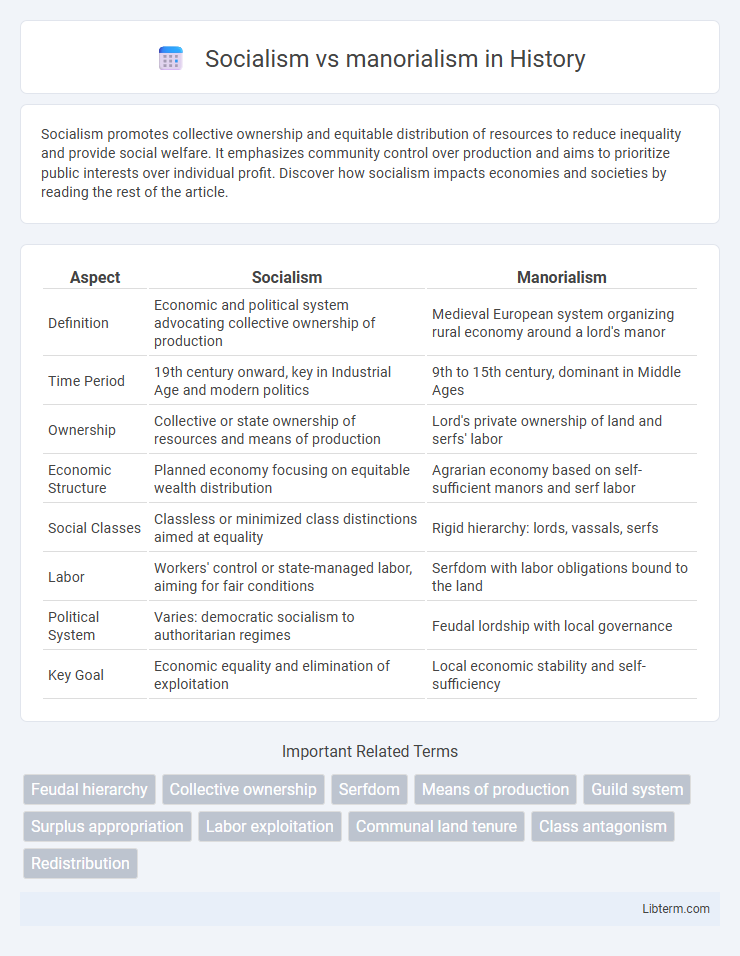Socialism promotes collective ownership and equitable distribution of resources to reduce inequality and provide social welfare. It emphasizes community control over production and aims to prioritize public interests over individual profit. Discover how socialism impacts economies and societies by reading the rest of the article.
Table of Comparison
| Aspect | Socialism | Manorialism |
|---|---|---|
| Definition | Economic and political system advocating collective ownership of production | Medieval European system organizing rural economy around a lord's manor |
| Time Period | 19th century onward, key in Industrial Age and modern politics | 9th to 15th century, dominant in Middle Ages |
| Ownership | Collective or state ownership of resources and means of production | Lord's private ownership of land and serfs' labor |
| Economic Structure | Planned economy focusing on equitable wealth distribution | Agrarian economy based on self-sufficient manors and serf labor |
| Social Classes | Classless or minimized class distinctions aimed at equality | Rigid hierarchy: lords, vassals, serfs |
| Labor | Workers' control or state-managed labor, aiming for fair conditions | Serfdom with labor obligations bound to the land |
| Political System | Varies: democratic socialism to authoritarian regimes | Feudal lordship with local governance |
| Key Goal | Economic equality and elimination of exploitation | Local economic stability and self-sufficiency |
Introduction to Socialism and Manorialism
Socialism is an economic and political system advocating collective ownership and equitable distribution of resources, emphasizing social welfare and reducing class disparities. Manorialism, predominant in medieval Europe, revolves around an agrarian-based economy where peasants worked the lord's land in exchange for protection and a share of the produce, creating a rigid hierarchical socio-economic structure. Understanding these frameworks highlights the transition from feudal economies to modern social and economic ideologies focused on equality and state control.
Historical Backgrounds of Socialism and Manorialism
Manorialism emerged during the early Middle Ages, serving as the economic structure of feudal Europe, where lords controlled large estates worked by serfs in a rigid hierarchical system. Socialism developed in the 19th century as a response to the Industrial Revolution's inequalities, advocating for collective ownership of production and wealth redistribution. While manorialism focused on agrarian economies and local self-sufficiency, socialism emphasizes industrial economies and social equity through state or communal control.
Core Principles of Manorialism
Manorialism centers on the organization of rural economy and society through a lord's manor, where peasants or serfs work the land in exchange for protection and a place to live. The core principles include a hierarchical structure with the lord holding legal and economic power, self-sufficient agricultural estates, and obligations like labor services, rents, or fees owed by peasants to the manor. This system contrasts with socialism, which emphasizes collective ownership and redistribution, rather than the personalized, land-based serfdom characteristic of manorialism.
Key Tenets of Socialism
Socialism emphasizes collective ownership of the means of production and aims to reduce economic inequality through wealth redistribution and social welfare programs. It advocates for centralized planning or democratic control of resources to ensure equitable access and social justice. In contrast, manorialism is a feudal economic system based on the lord's control over land and serfs, emphasizing agrarian self-sufficiency and hierarchical social order.
Economic Structures: Agricultural vs. Industrial
Socialism emphasizes industrial economic structures characterized by collective or state ownership of production means, promoting centralized planning and distribution. Manorialism, rooted in the feudal agrarian system, relies on agricultural economic structures where lords own land and peasants provide labor and produce in a self-sufficient manor economy. The transition from manorial agricultural dependency to socialism's industrial focus marks a fundamental shift in production, labor organization, and resource allocation.
Social Hierarchies and Class Relations
Socialism advocates for the abolition of rigid social hierarchies by promoting collective ownership and egalitarian class relations, aiming to reduce economic disparities through wealth redistribution. Manorialism, rooted in feudal systems, enforces strict social stratification where serfs and peasants are bound to the land under the authority of lords, perpetuating entrenched class privileges and limited social mobility. The contrast highlights socialism's goal of classless society against manorialism's preservation of hierarchical estates and service obligations.
Land Ownership and Resource Distribution
Socialism advocates for collective or state ownership of land and resources, aiming for equitable distribution based on individual needs and contributions. Manorialism centers on a feudal system where land is owned by a lord and worked by serfs, with resources allocated according to hierarchical obligations and rigid social structures. The fundamental difference lies in socialism's emphasis on communal property rights and equality, whereas manorialism reinforces unequal land ownership tied to feudal authority.
Role of the State and Governance
Socialism involves extensive state control over resources and centralized governance to achieve economic equality and social welfare. Manorialism operates under a decentralized feudal system where governance is primarily local, vested in the lord of the manor with limited state interference. The state's role in socialism centers on regulation and redistribution, whereas in manorialism, governance is characterized by personal loyalty and land-based authority.
Impact on Daily Life and Community Organization
Socialism promotes collective ownership and equal resource distribution, enhancing community cohesion and access to essential services such as healthcare and education. Manorialism, rooted in feudal systems, structured daily life around agricultural labor and hierarchical obligations, limiting social mobility and centralizing power in the hands of the lord. The shift from manorialism to socialism transforms community organization by replacing rigid class structures with cooperative governance aimed at improving living standards and reducing inequality.
Legacy and Modern Relevance
Socialism's legacy lies in its advocacy for wealth redistribution, social welfare, and public ownership, influencing modern policies on healthcare, education, and workers' rights worldwide. Manorialism, rooted in medieval European feudalism, shaped rural economies and social hierarchies but holds limited direct relevance today, mainly informing historical and economic studies. Contemporary socio-economic systems retain echoes of socialism's egalitarian goals, while manorialism serves as a historical framework for understanding feudal societies and agrarian structures.
Socialism Infographic

 libterm.com
libterm.com